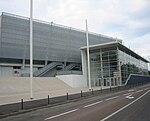Canton of Besançon-2
Cantons of DoubsDoubs geography stubs
The canton of Besançon-2 is an administrative division of the Doubs department, eastern France. It was created at the French canton reorganisation which came into effect in March 2015. Its seat is in Besançon.It consists of the following communes:
Excerpt from the Wikipedia article Canton of Besançon-2 (License: CC BY-SA 3.0, Authors).Canton of Besançon-2
Cité des Montboucons, Besançon Montboucons
Geographical coordinates (GPS) Address Nearby Places Show on map
Geographical coordinates (GPS)
| Latitude | Longitude |
|---|---|
| N 47.25 ° | E 6 ° |
Address
Cité des Montboucons
Cité des Montboucons
25000 Besançon, Montboucons
Bourgogne-Franche-Comté, France
Open on Google Maps





